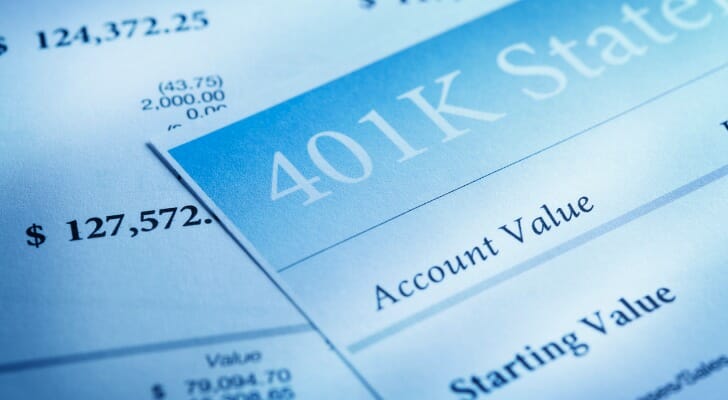
For the most part, the money you place in your retirement accounts is untouchable during your working years. If you follow these rules, the IRS affords you various tax benefits for saving for retirement. However, there may come a time when you need money and have no choice but to pull funds from your 401(k). Two viable options include 401(k) loans and hardship withdrawals. A 401(k) loan is generally more attainable than a hardship withdrawal, but the latter can come in handy during times of financial strife.
A financial advisor could help you put a financial plan together for your retirement needs and goals.
What Is a 401(k) Loan?
A 401(k) loan entails borrowing money from your personal 401(k). This means you’re borrowing from yourself to help cover mortgage payments, bills or any other urgent debts. In turn, you must pay back every bit of the money that you take out of your account.
To initiate a 401(k) loan, you must meet three major IRS requirements:
- Apply for the loan through your plan administrator
- The loan must be for no more than 50% of the vested account balance or $50,000, whichever is less
- You must make payments at least quarterly and repay the loan fully within five years
For example, let’s say that John has a 401(k) account with a $60,000 balance. He may borrow up to $30,000 from this account, as this is 50% of his total balance. On the other hand, Robert has a $200,000 401(k) account. While 50% of his balance would be $100,000, he can only take out $50,000, as per the IRS borrowing cap.
A borrower can take out multiple loans at the same time, as long as they’re collectively below the borrowing limit. Note that these stipulations differ if your account balance is below $10,000. In this situation, the IRS allows the 401(k) plan to lend up to the full amount of the borrower’s account.
The specifics of your repayment terms are up to your 401(k) plan. In most cases, these will call for full repayment within five years and at least quarterly payments. Some exceptions include:
- Loans to buy a primary residence
- If the employee is actively serving in the military
- A leave of absence of up to one year
Not every 401(k) plan will let you take out a loan. This decision is ultimately at the discretion of your employer and the plan administrator. However, only employer-related plans can offer loans; you can’t borrow from an IRA.
What Are Hardship Withdrawals?

A hardship withdrawal is when you take money early from your 401(k) account in response to an immediate, urgent financial need. While early withdrawals (those made before you reach the age of 59.5) normally come with a 10% penalty, this penalty does not apply to hardship withdrawals. Ordinary income taxes do apply, though. Unlike a 401(k) loan, you do not need to pay it back – though it’s obviously a good idea to eventually replenish the balance so you get back on track with your retirement plan.
According to the IRS, to take a hardship withdrawal from your 401(k) account, you must:
- Demonstrate an “immediate and heavy financial need,” and
- Take only “the amount necessary to satisfy that financial need”
Your employer decides whether your financial need meets the “immediate and heavy” test. As a general rule, basic consumer purchases and debts won’t satisfy this test. Wanting to buy a new living room sofa or pay off a credit card bill will not justify a hardship withdrawal.
However, a financial need does not have to be sudden and unexpected. In the words of the IRS, “a financial need may be immediate and heavy even if it was reasonably foreseeable or voluntarily incurred by the employee.”
Although your employer has discretion in most situations, the IRS automatically qualifies a hardship withdrawal for six reasons:
- Medical expenses for you, your spouse, dependents or the account’s beneficiary
- Closing costs and other charges related to buying your principal residence, aside from mortgage payments
- Tuition, room and board and other costs associated with a college education for you, your spouse, dependents or the account’s beneficiary over the next year
- Payments to prevent eviction or foreclosure on your primary residence
- Funeral expenses for you, your spouse, dependents or the account’s beneficiary
- Qualifying expenses to repair damage to your primary residence (often involves substantial damage to the property)
The IRS explicitly states that you cannot withdraw more money than you need. To ensure you don’t break this rule, the withdrawal can be no more than the amount needed to cover the expense. That means you can’t take out $1,100 for a $1,000 repair job.
You are also not able to rely on a hardship withdrawal if you have alternative funding sources available. This could include your personal savings, insurance, liquidation of unnecessary assets or a 401(k) loan. Additionally, if you can raise the money by discontinuing 401(k) contributions for a time, you will not qualify for a hardship withdrawal. In fact, after taking a hardship withdrawal, the IRS will require you to discontinue contributions for at least six months.
You can take a hardship withdrawal if alternative methods would cause more problems than they would solve. For example, if you own a pleasure boat, the IRS will probably require that you sell it rather than take a hardship withdrawal. Conversely, if you make your living as a fisherman, the IRS will not ask that you liquidate your principal form of income.
Pros and Cons of 401(k) Loans and Hardship Withdrawals

Taxes are a major differentiating factor when it comes to deciding between a 401(k) loan and a hardship withdrawal. For hardship withdrawals, your money will be taxed penalty-free under ordinary income taxes.
401(k) loans avoid income taxes, as the money technically isn’t income. However, you must pay the loan back in full and on time, and failure to do so will typically trigger the 10% early withdrawal penalty on top of the standard income tax. At this point, your loan will become a “deemed distribution.”
Unlike hardship withdrawals, the purpose of a 401(k) loan is completely irrelevant. As long as your plan allows for a loan and you meet all of the requirements, you can borrow money. There’s no need to justify this decision because, in the end, you’ll be paying every dime back.
401(k) loans don’t come without consequences, though. Because you must repay what you borrow, there might be interest, depending on your plan. The good news is that, because you’re borrowing from yourself, the interest ultimately gets paid back to you. Still, because the interest is not pre-tax (it’s not money that was deducted from a paycheck), this interest is a contribution that doesn’t benefit from the usual favorable tax treatment of a 401(k) contribution.
You’ll also be on the hook for payments even if you leave your employer. If you can’t, the plan will consider the loan an early distribution and report it to the IRS as such.
Both hardship withdrawals and 401(k) loans have significant effects on your long-term retirement savings. Although you will ultimately pay back your balance with a loan, you’ll lose out on all the growth your retirement account could have made during this period. But if you bear in mind that you cannot contribute to your 401(k) for at least six months after a hardship withdrawal, these can potentially affect your account balance much more heavily.
Although hardship withdrawals can be extremely helpful, they can be difficult to qualify for. Check with your employer to see if they’re even an option for you.
Bottom Line
If you really need to take money from your 401(k), your main options are a 401(k) loan or a hardship withdrawal. The loan option will need to be paid back; the hardship withdrawal will not, but you can only qualify for one under certain circumstances. If you borrow money and can’t pay it back, or if you don’t qualify for a hardship withdrawal, you’ll get hit with a 10% IRS tax penalty for your early withdrawal.
Next Steps for Retirement Planning
- Finding a financial advisor doesn’t have to be hard. SmartAsset’s free tool matches you with up to three vetted financial advisors who serve your area, and you can have a free introductory call with your advisor matches to decide which one you feel is right for you. If you’re ready to find an advisor who can help you achieve your financial goals, get started now.
- Use SmartAsset’s free retirement calculator to see if you’re on track to meet your goals.
Photo credit: ©iStock.com/outline205, ©iStock.com/DNY59, ©iStock.com/skynesher